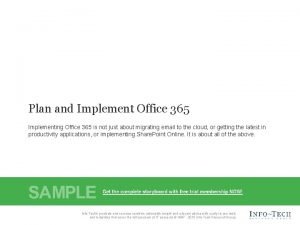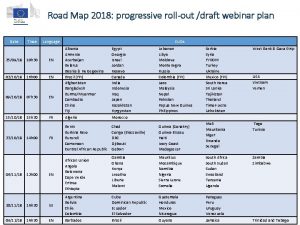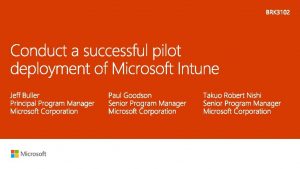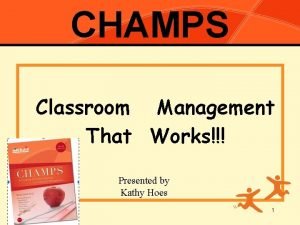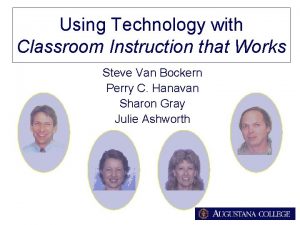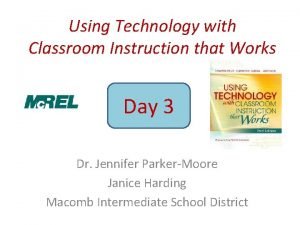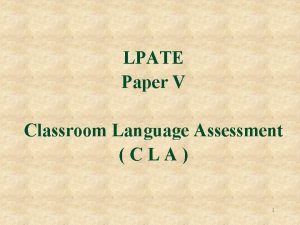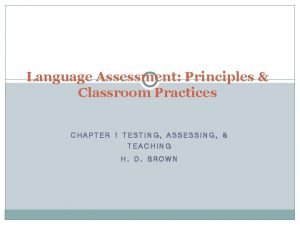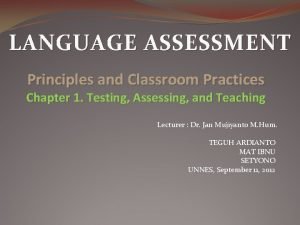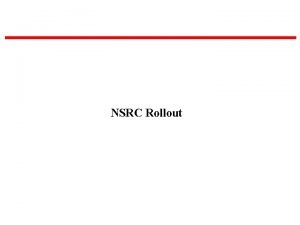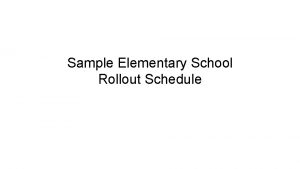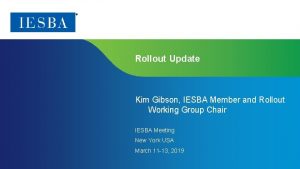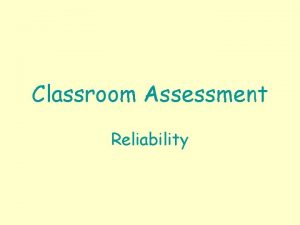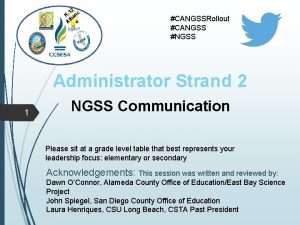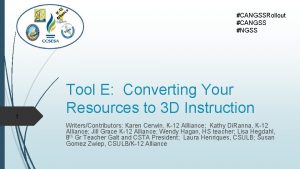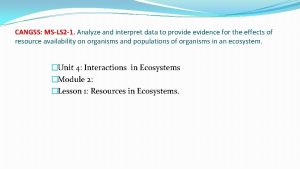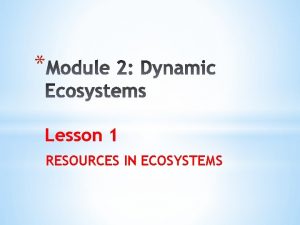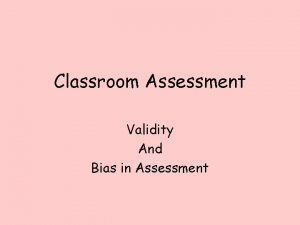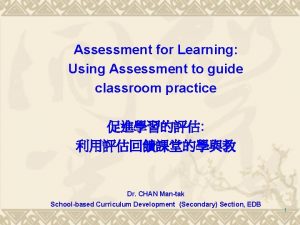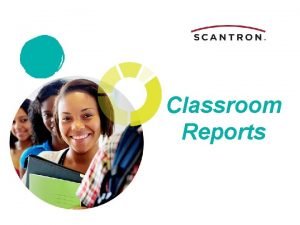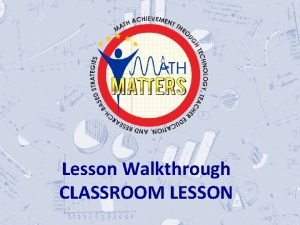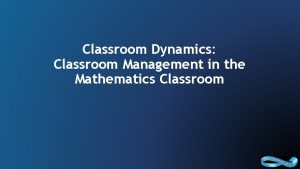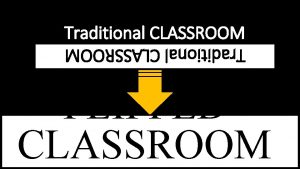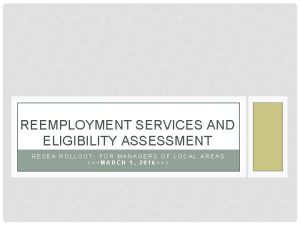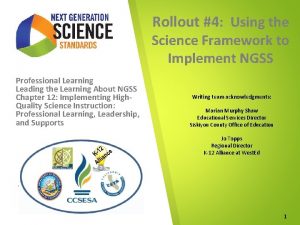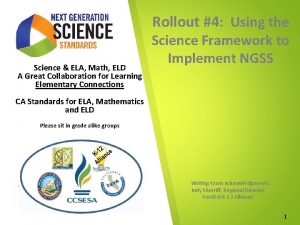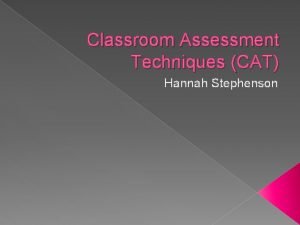Rollout 4 Using the Classroom Assessment CANGSSRollout CANGSS

































- Slides: 33

Rollout #4: Using the Classroom Assessment #CANGSSRollout #CANGSS #NGSS Science Framework to Implement NGSS Writing team acknowledgments: Yamileth Shimojyo, Riverside County Office of Education; Ellen Raco, Tracy Unified School District; Peter A’Hearn, Palm Springs Unified Shool District Editing team acknowledgments: Wendy Hagan, Granada Hills Charter HS 1

Session Outcomes ▸ Understand the importance of a cohesive assessment system, from the classroom to the state assessment ▸ Focus on formative and summative assessment and analyze how assessments are built into the learning sequences ▸ Get acquainted with the Science Framework assessment chapter and other resources Using the CA Science Framework to Implement the NGSS: Statewide Rollout 2

Magnetic Words Look around the room at assessment words Select one that either attracts you, or repels you Go to that word; form small groups of 4 Introduce yourselves and why you selected the word Be prepared to share out to the whole group Using the CA Science Framework to Implement the NGSS: Statewide Rollout 3

Assessment System Classroom CA Framework Chapter 7 Adapted from Herman and Heritage 2007. district benchmarks Using the CA Science Framework to Implement the NGSS: Statewide Rollout state assessment 4

Focus on Classroom Assessment Using the CA Science Framework to Implement the NGSS: Statewide Rollout 5

Formative vs. Summative Assessment With a partner discuss what these two terms mean. Formative assessment is used to inform instruction within a learning sequence (Assessment FOR Learning ) Summative assessment is used to summarize student learning at the end of a learning sequence. (Assessment OF Learning) Using the CA Science Framework to Implement the NGSS: Statewide Rollout 6

What Are The Characteristics of a High Quality Classroom Assessment? ▸ ▸ Table Carousel ▹ Use one piece of paper for each group. ▹ First person, add one idea and pass the paper to the person on your left. ▹ Next person adds their idea and passes paper to the person on their left. ▹ Continue until everyone has had an opportunity to give one idea. ▹ Continue passing as long as the ideas are flowing! Be prepared to share ideas from your carousel with the whole group. Using the CA Science Framework to Implement the NGSS: Statewide Rollout 7

CAESL Framework 3 dimensional student learning Quality Goals for Student Learning and Progress Ali gn t en em me fin nt Re Assessment/ Instruction Cycle Quality Tools Quality Use Sound Interpretation H 1 Using the CA Science Framework to Implement the NGSS: Statewide Rollout 8

Code Your List Quality Goals for Student Learning - G 3 dimensional student learning Quality Goals for Student Learning and Progress Quality Tools – T Ali g t en em nm fin en t Re Quality Use - U Assessment/ Instruction Cycle Quality Tools H 1 Quality Use Sound Interpretation Using the CA Science Framework to Implement the NGSS: Statewide Rollout 9

Characteristics of NGSS Assessments ▸ Examine students’ performance of SEPs in the context of DCIs and CCCs ▸ Contain multiple components (items) that may individually assess one of the dimensions, but, together support inferences about students’ 3 D science learning in a given PE ▸ Accurately locate students along a progressively more complex understanding of a core idea and more sophisticated applications of SEPs and CCCs ▸ Evaluate a range of student responses that are specific enough to be useful for helping teachers understand the range of student learning. NRC 2014 Using the CA Science Framework to Implement the NGSS: Statewide Rollout 10

Debrief the Learning Sequence Pika Are Chill Using the CA Science Framework to Implement the NGSS: Statewide Rollout 11

Review the Learning Sequence Storyline Anchor Phenomena = The 6 th Extinction Investigative Phenomena = Decrease in Pika Population Refer to your Climate Change and the Stability of Populations Conceptual Flow Using the CA Science Framework to Implement the NGSS: Statewide Rollout 12

Directions for the Learning Sequence Debrief Jigsaw ▸ Facilitator will assign your table a topic: ▹ ▹ Phenomenon Formative Assessment Questioning Use of Notebooks ▸ Use H 2 for questions to guide your debrief discussion ▸Be prepared to share your ideas with the whole group H 2 Using the CA Science Framework to Implement the NGSS: Statewide Rollout 13

Learning Sequence Debrief: Analyzing Student Work Created at the NGSS Framework Rollout Vetting Session, Rancho Cordova, CA, 2/12/17 Created at the NGSS Framework Rollout, San Joaquin County Office of Education, 5/3/17 Refer to your Climate Change and the Stability of Populations Conceptual Model Using the CA Science Framework to Implement the NGSS: Statewide Rollout 14

Learning Sequence Debrief: Analyzing Student Work Analyze the conceptual model your team created yesterday. Write a Claim to the answer the following: What is your understanding of the causes that affect stability and change in Pika populations? Write in your Notebook. Discuss with your group. Using the CA Science Framework to Implement the NGSS: Statewide Rollout 15

About Scratch 16 H 3 a-c

Summative Assessment. Task 1: Computer Coding with Scratch https: //scratch. mit. edu/projects/128765571/#editor Click “See Inside” Play with the Code 1. 17 Scripts 2. 5 Sprites H 3 a-c R 3 Engaging in the creation of computational artifacts prepares young people for more than careers as computer scientists or programmers. It supports young people’s development as computational thinkers - individuals who can draw on computational concepts, practices and perspectives in all aspects of their lives, across disciplines and contexts. (ttp: //scratched. gse. harvard. edu/guide/ ) 17

Summative Assessment. Task 2: Revise Simulation What changes would you make to the model (hands-on or computer) to improve the simulation of the effect of climate change on the Pikas? 18 H 2

Summative Assessment. Task 2: Revise Simulation Claim: The Simulation would be a better model of stability and change in Pika population if. . . Evidence: The evidence to support these changes are. . . (this can be both qualitative or quantitative) Reasoning: The simulation would improve because. . . 19 H 2

Summative Assessment. Task 3: The “Pika Are Chill” Infographic What modifications were made to the simulations? What have you learned about model revision? What further modifications are needed? What data would help improve the simulation? What have you learned about the causes that affect stability and change in a population? H 2 20

Summative Assessment: Debrief Deconstruct the assessment: ● What are the components of construct of an explanation and how were they addressed in the task? ● Which practices were used for “evidence” and how were the components of the SEP determined? ● Which CCCs were selected to frame the explanation and how were the components of the CCC determined? ● How were the DCIs used as part of the reasoning? Using the CA Science Framework to Implement the NGSS: Statewide Rollout 21

Looking Back: Goals, Tools, Use 3 dimensional student learning Quality Goals for Student Learning and Progress Ali gn t en em me fin nt Re Assessment/ Instruction Cycle Quality Tools Quality Use Sound Interpretation H 1 Using the CA Science Framework to Implement the NGSS: Statewide Rollout 22

Resources For Constructing Assessments ● Learning sequence performance task (SEP, DCI, CCC) ● Assessment and the 5 Es ● Evidence Statements: Appendix of Observable Features (Shells) ● SEP Learning Progressions: California Science Framework Appendices ● CCC Learning Progressions: California Science Framework Appendices Using the CA Science Framework to Implement the NGSS: Statewide Rollout 23

Assessment and the 5 Es Stage Learning Activity Assessment Purpose Engage Elicit prior knowledge Explore Building understanding Explain Tentative explanation Elaborate Application of understanding Evaluate Generalization (explanation with application Using the CA Science Framework to Implement the NGSS: Statewide Rollout Strategies or Tools to serve assessment purpose 24

Assessment and the 5 Es Stage Learning Activity Assessment Purpose Strategies or Tools to serve assessment purpose Engage Elicit prior knowledge Bubble map, storyboard, probe Explore Building understanding Notebook entries (gathering data) Metacognitive links Explain Tentative explanation Notebook entries (sense making prompts) Elaborate Application of understanding Selecting data to serve as evidence from a large data set Evaluate Generalization (explanation Conducting a town hall with application meeting Using the CA Science Framework to Implement the NGSS: Statewide Rollout 25

Achieve’s Evidence Statements – An Analogy PE Using the CA Science Framework to Implement the NGSS: Statewide Rollout Evidence Statement 26

Key “Is/Is Not” Statements WHAT IT IS NOT Describes what it looks like for students to fully satisfy the PE Used as a checklist that denotes the order or sequence of steps in a student’s performance Supports instructional design Used as a description of teacher prompts, steps in a classroom Describes a “proficient” level activity, or instructional of understanding techniques To be used as a complete scoring rubric Using the CA Science Framework to Implement the NGSS: Statewide Rollout 27

Evidence Statements • HS ETS 1 -4 • HS LS 4 -6 • HS ESS 3 -5 • HS ESS 3 -6 H 5 a-d Using the CA Science Framework to Implement the NGSS: Statewide Rollout 28

Explore the K-12 “Observable Features” With a partner, select 1 practice Read the appendix and discuss the “observable features” for the practice What are the components of the practice? How do the “observable features” contribute to the learning progression of the practices? To student understanding? H 6 a-e Using the CA Science Framework to Implement the NGSS: Statewide Rollout 29

Framework examples Developing and using models ▸…By high school, these models can be more abstract, conceptual models represented by concept maps, mathematical models, or even computer codes. ▸In almost all cases, these are models of systems [CCC-4]. ▸The NGSS Evidence Statements (Achieve 2015) define three key elements that are a part of every model: components, relationships, and connections. ▸Systems have components that interact with one another (these interactions are called ‘Relationships’ in the NGSS Evidence Statements). ▸Models can be applied to understanding phenomena and predicting the behavior of the overall system (these applications are called ‘connections’ in the NGSS Evidence Statements). ▸One way to assess whether or not students have developed models of systems is to provide mediums for them to illustrate the mental models that are inside their heads. These mediums can be materials to make physical models or abstract representations such as pictorial models. H 7 Using the CA Science Framework to Implement the NGSS: Statewide Rollout 30

Other Grade Level Resources NGSS Assessment Report Ø https: //www. nap. edu/catalog/18409/developing-assessments-for-the-nextgeneration-science-standards Ø Developing Assessments for the NGSS, West. Ed Ø http: //www. csai-online. org/collection/1565 The SNAP project Ø https: //web. stanford. edu/group/ngss_assessment/cgi-bin/snapgse/ Classroom Samples Tasks, Achieve Ø http: //www. nextgenscience. org/classroom-sample-assessment-tasks/ NGSS/CCSS-M Sample Classroom Assessment Tasks Ø http: //www. nextgenscience. org/sites/default/files/Sci. Math. Tasks. Front. Matter. Draft-Nov%202014. pdf The Concord Consortium Ø https: //concord. org/projects/ngss-assessments ; http: //nextgenscienceassessment. org/ Ø Ø Ø Performance Assessment Resource Bank https: //www. performanceassessmentresourcebank. org/ Using the CA Science Framework to Implement the NGSS: Statewide Rollout 31

Reflection Based on your learning from the lesson and this session on assessment, comment on the following statement and how it will impact your classroom: Assessment and instruction are two sides of the same coin. Using the CA Science Framework to Implement the NGSS: Statewide Rollout 32

Phenomenon-Based Instruction and Assessment You have completed a sequence of learning about phenomenon, how to construct a phenomenon-based learning sequence, and how to plan for three dimensional assessments. There is much more to learn! Contact the NGSS Collaboration Team for Assistance COEs, CSTA, CSP, K-12 Alliance @ West. Ed Using the CA Science Framework to Implement the NGSS: Statewide Rollout 33
 Office 365 implementation project plan
Office 365 implementation project plan Progressive rollout
Progressive rollout Intune deployment project plan
Intune deployment project plan Office 365 rollout and adoption workbook
Office 365 rollout and adoption workbook Cse smart class
Cse smart class Champs behavior management
Champs behavior management Using wordle in the classroom
Using wordle in the classroom Using technology with classroom instruction that works
Using technology with classroom instruction that works Using technology with classroom instruction that works
Using technology with classroom instruction that works Lpate
Lpate Language assessment: principles and classroom practices
Language assessment: principles and classroom practices Language assessment principles and classroom practices
Language assessment principles and classroom practices Hát kết hợp bộ gõ cơ thể
Hát kết hợp bộ gõ cơ thể Slidetodoc
Slidetodoc Bổ thể
Bổ thể Tỉ lệ cơ thể trẻ em
Tỉ lệ cơ thể trẻ em Chó sói
Chó sói Tư thế worm breton là gì
Tư thế worm breton là gì Hát lên người ơi alleluia
Hát lên người ơi alleluia Các môn thể thao bắt đầu bằng tiếng bóng
Các môn thể thao bắt đầu bằng tiếng bóng Thế nào là hệ số cao nhất
Thế nào là hệ số cao nhất Các châu lục và đại dương trên thế giới
Các châu lục và đại dương trên thế giới Công thức tiính động năng
Công thức tiính động năng Trời xanh đây là của chúng ta thể thơ
Trời xanh đây là của chúng ta thể thơ Mật thư tọa độ 5x5
Mật thư tọa độ 5x5 Làm thế nào để 102-1=99
Làm thế nào để 102-1=99 Phản ứng thế ankan
Phản ứng thế ankan Các châu lục và đại dương trên thế giới
Các châu lục và đại dương trên thế giới Thể thơ truyền thống
Thể thơ truyền thống Quá trình desamine hóa có thể tạo ra
Quá trình desamine hóa có thể tạo ra Một số thể thơ truyền thống
Một số thể thơ truyền thống Bàn tay mà dây bẩn
Bàn tay mà dây bẩn Vẽ hình chiếu vuông góc của vật thể sau
Vẽ hình chiếu vuông góc của vật thể sau Nguyên nhân của sự mỏi cơ sinh 8
Nguyên nhân của sự mỏi cơ sinh 8
